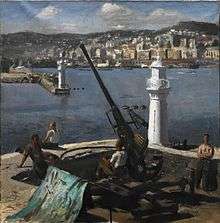Henry Carr (artist)
| Henry Carr | |
|---|---|
.jpg) Carr painting a portrait of Edward Ardizzone | |
| Born |
16 August 1894 Leeds, England |
| Died |
16 March 1970 (aged 75) South Kensington, London |
| Nationality | British |
| Education | |
| Known for | Painting, drawing |
Henry Marvell Carr, RA RP RBA, (16 August 1894 – 16 March 1970) was a successful British landscape and portrait painter who served as a war artist during World War II.[1]
Early life


Carr was born in Leeds and trained at Leeds College of Art and the Royal College of Art, under William Rothenstein. During World War I he served in France with the Royal Field Artillery. After the war his work was exhibited at the Royal Academy in 1921, in other British galleries and in Paris. He painted portraits of, among others, Aldous Huxley and Olivia Davis and landscapes of the English south coast.[2]
World War II
At the outbreak of World War II, Carr was offered commissions by the War Artists' Advisory Committee to paint scenes of bomb damage in London, both to landmarks such as St. Pancras Station and St. Clement Danes Church and to housing in the suburbs. An exhibition of his war paintings was held at the National Gallery in July 1940.[2] Carr's own home and studio were destroyed in the Blitz.[3] A trip on a British merchant navy ship resulted in the paintings The Merchant Navy:The Chain Locker and Merchant Seaman Fireman. In 1943 Carr became a full-time, salaried, War Office Artist and travelled first to North Africa and then to Italy. As well as portraits of Allied soldiers and officers, he painted military actions and landscapes in Algiers, Tunis, Cassino and Sessa in Italy. In 1944, he witnessed, and painted, an eruption of Mount Vesuvius. Later in 1944 he left Italy after becoming ill.[4]
Post-war career
After the war, Carr resumed his career as a portrait painter. In 1948 he was elected a Fellow of the Royal Society of Portrait Painters and in 1956 he was awarded the Gold Medal at the Paris Salon.[1] Between 1957 and 1959 he produced a series of fourteen murals, showing the stages of textile production for the Salts Mill.[5] Carr taught at Beckenham Art School for some seventeen years and became Head of the School.[6] Carr was a member of the Royal Society of British Artists. He was elected an Associate Member of the Royal Academy in 1957 and a full member in 1966 and continued to exhibit there until his death.[1][7] Some seventy works by him are held by the Imperial War Museum.[2]
References
- 1 2 3 Brian Stewart & Mervyn Cutten (1997). The Dictionary of Portrait Painters in Britain up to 1920. Antique Collectors' Club. ISBN 1 85149 173 2.
- 1 2 3 Ronan Thomas (3 December 2010). "Henry Marvell Carr 1894-1970". 'West End at War'. Retrieved 20 September 2013.
- ↑ Art from the Second World War. Imperial War Museum. 2007. ISBN 978-1-904897-66-8.
- ↑ Brain Foss (2007). War paint: Art, War, State and Identity in Britain, 1939-1945. Yale University Press. ISBN 978-0-300-10890-3.
- ↑ Dave Shaw (July 2007). "Salt's Textile Production Captured in Paintings the work of Henry Carr". 'Saltaire History Club'. Retrieved 20 September 2013.
- ↑ Frances Spalding (1990). 20th Century Painters and Sculptors. Antique Collectors' Club. ISBN 1 85149 106 6.
- ↑ "Henry Carr R.A". Royal Academy. Retrieved 1 September 2016.
External links
| Wikimedia Commons has media related to Henry Carr. |
- Paintings by Henry Carr at the Art UK site